Legendre transformation without Legendre transformation
If you heard something of theoretical mechanics, you definitely
know that the most important transition in mechanics is one from Lagrangian Mechanics to Hamiltonian. And its name is
Legendre transform.
This transition is like a magic trick with all cards open, when you know secret recipe, but still don't grasp what just happened. The recipe is
This transition is like a magic trick with all cards open, when you know secret recipe, but still don't grasp what just happened. The recipe is
- take the momenta: $p_i=\frac{\partial L}{\partial \dot{q_i}}$.
- prove that Hamilton equations hold: $$\frac{\partial H}{\partial q_j}=-\dot{p}_j,\qquad\frac{\partial H}{\partial p_j}=\dot{q}_j$$ where $$ H\left(q,\;p,\;t\right)=\sum_i\dot{q}_i p_i-L(q,\;\dot{q},\;t)$$
And that's the idea.
But why should I take this Hamiltonian not some other function?
Why should I consider Lagrangian derivatives as new variables instead of $q_i$ ?
I didn't meet the answers in mechanics courses, though there is a simple intuitive justification.
Thanks to Pasha Gavrilenko who revealed this secret.
What do we have initially? An action on some interval of time, i.e. the integral
$$ S = \min_{q(\cdot)} \int_{t_1}^{t_2} L(q, \dot{q}, t) dt$$ which should be minimized (locally), that's
what Hamilton's principle states. (There are conditions at the endpoints which I will omit)
Ok, the only trouble is $q$ and $\dot{q}$ aren't independent, otherwise the Lagrange equations would be much
simpler: $ \frac{\partial L}{\partial q} = \frac{\partial L}{\partial \dot{q}} = 0 $
Let us try to replace $\dot{q}$ with $v$, assuming they are equal: $$ S = \min_{q(\cdot)} \int_{t_1}^{t_2} L(q, v, t)\bigg|_{v=\dot q} dt $$
Hmhmhm. Seems nothing changed. Now the trick! Let's add a summand
$$\delta(\dot{q},v) = \begin{cases} 0 & \dot{q} = v \\ +\infty & \text{otherwise} \end{cases}$$ and now we can minimize over all possible trajectories of $q$ and of $v$. $$ S = \min_{q(\cdot), v(\cdot)} \left[ \int_{t_1}^{t_2} L(q, v, t) dt + \delta[q,v] \right] $$
See? We have now $q$ and $v$ independent at the cost of an additional summand. Now we can write $\delta$ in the following form (make sure you understand it):
$$\delta[q,v] = \max_{p(\cdot)} \int_{t_1}^{t_2} p(t) (\dot{q}(t) - v(t)) dt $$
After substitution we have the problem on finding a saddle point of the function: $$ S = \min_{q(\cdot), v(\cdot)} \max_{p(\cdot)} \int_{t_1}^{t_2} p(t) (\dot{q}(t) - v(t)) + L(q, v, t) dt $$ Pay attention that all variables $p,q,v$ are independent now. The solution we need is a trajectory $q(\cdot)$, but it has corresponding trajectories $v(\cdot)$ and $p(\cdot)$ which form a saddle point together with $q(\cdot)$.
As we know, at the saddle point all the partial derivatives are zero (assuming the function is differentiable). Calculating variational derivatives with respect to $p,v,q$ gives respectively $$ \begin{aligned} \dot{q} &= v \\ p &= \frac{\partial L}{\partial \dot{q}} \\ \dot{p} &= \frac{\partial L}{\partial q} \end{aligned} $$ Note that energy function $H(q,v,t)$ also appeared in a natural way as well as the Hamiltonian version of the principle of least action $$ \begin{aligned} p(t) (\dot{q}(t) - v(t)) + L(q, v, t) = p(t) \dot{q}(t) - \left[ p(t)v(t) - L(q,v,t) \right] = \\ = \{\text{changing the variables} \} = p(t) \dot{q}(t) - H(p,q,t) \end{aligned} $$
You may have noticed that the thing I did is just added Lagrange multiplier ho make the condition $\dot{q} = v$ hold.
This way Legendre transformation looks more accessible to my mind.
Let us try to replace $\dot{q}$ with $v$, assuming they are equal: $$ S = \min_{q(\cdot)} \int_{t_1}^{t_2} L(q, v, t)\bigg|_{v=\dot q} dt $$
Hmhmhm. Seems nothing changed. Now the trick! Let's add a summand
$$\delta(\dot{q},v) = \begin{cases} 0 & \dot{q} = v \\ +\infty & \text{otherwise} \end{cases}$$ and now we can minimize over all possible trajectories of $q$ and of $v$. $$ S = \min_{q(\cdot), v(\cdot)} \left[ \int_{t_1}^{t_2} L(q, v, t) dt + \delta[q,v] \right] $$
See? We have now $q$ and $v$ independent at the cost of an additional summand. Now we can write $\delta$ in the following form (make sure you understand it):
$$\delta[q,v] = \max_{p(\cdot)} \int_{t_1}^{t_2} p(t) (\dot{q}(t) - v(t)) dt $$
After substitution we have the problem on finding a saddle point of the function: $$ S = \min_{q(\cdot), v(\cdot)} \max_{p(\cdot)} \int_{t_1}^{t_2} p(t) (\dot{q}(t) - v(t)) + L(q, v, t) dt $$ Pay attention that all variables $p,q,v$ are independent now. The solution we need is a trajectory $q(\cdot)$, but it has corresponding trajectories $v(\cdot)$ and $p(\cdot)$ which form a saddle point together with $q(\cdot)$.
As we know, at the saddle point all the partial derivatives are zero (assuming the function is differentiable). Calculating variational derivatives with respect to $p,v,q$ gives respectively $$ \begin{aligned} \dot{q} &= v \\ p &= \frac{\partial L}{\partial \dot{q}} \\ \dot{p} &= \frac{\partial L}{\partial q} \end{aligned} $$ Note that energy function $H(q,v,t)$ also appeared in a natural way as well as the Hamiltonian version of the principle of least action $$ \begin{aligned} p(t) (\dot{q}(t) - v(t)) + L(q, v, t) = p(t) \dot{q}(t) - \left[ p(t)v(t) - L(q,v,t) \right] = \\ = \{\text{changing the variables} \} = p(t) \dot{q}(t) - H(p,q,t) \end{aligned} $$
You may have noticed that the thing I did is just added Lagrange multiplier ho make the condition $\dot{q} = v$ hold.
This way Legendre transformation looks more accessible to my mind.
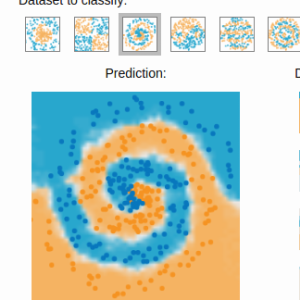 Gradient boosting
Gradient boosting 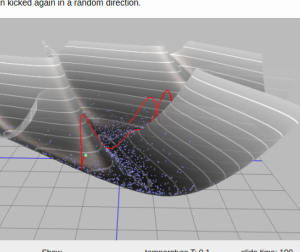 Hamiltonian MC
Hamiltonian MC 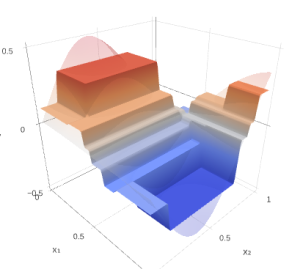 Gradient boosting
Gradient boosting 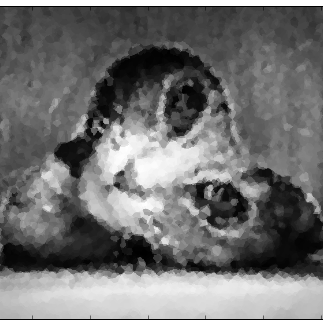 Reconstructing pictures
Reconstructing pictures 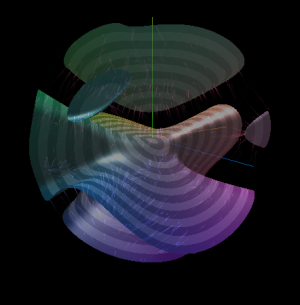 Neural Networks
Neural Networks